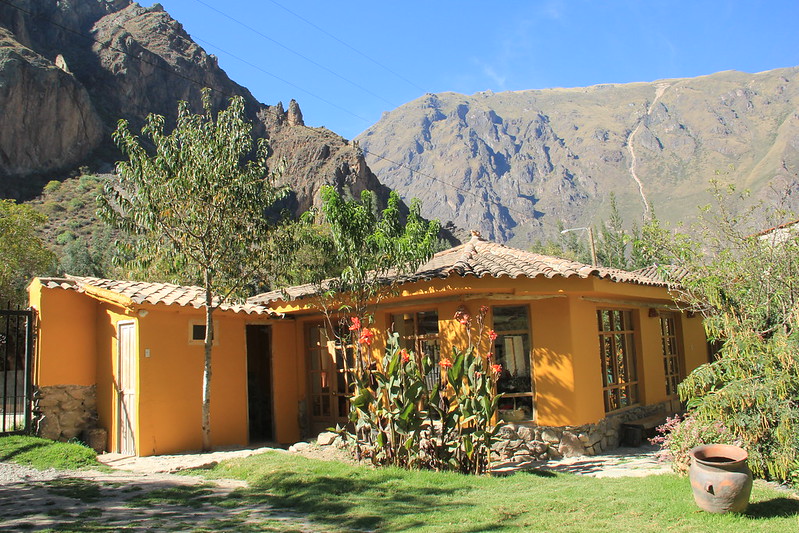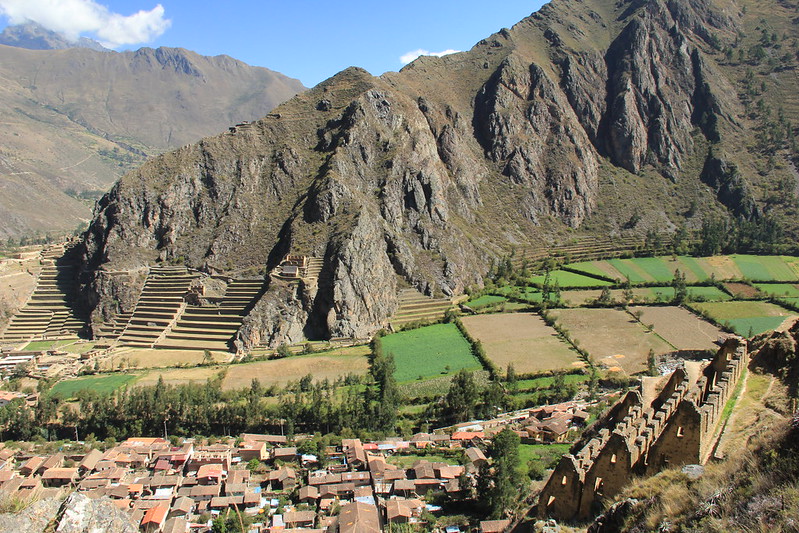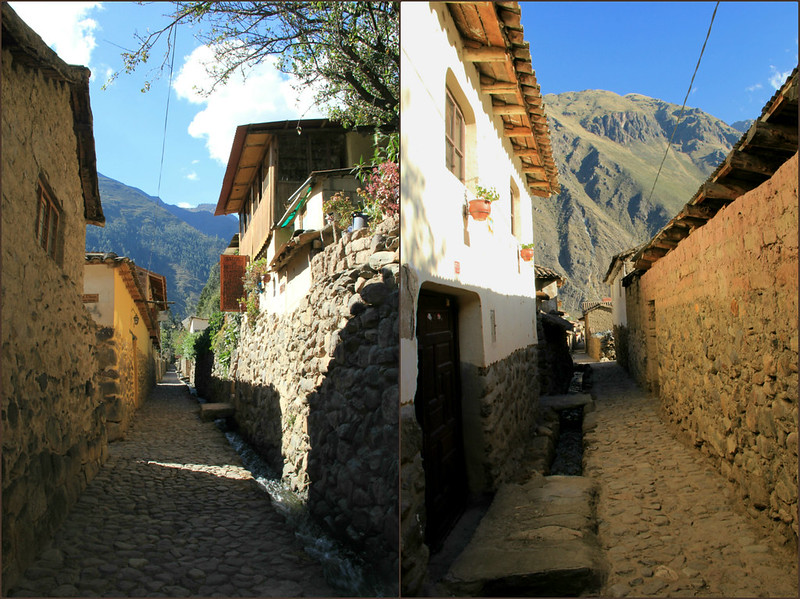A lot of people only visit Ollantaytambo (known as Ollanta by locals and visitors alike) as part of their Inca Trail trek. This quaint little village with a population of just 700 is where most tour groups (ours included) stop for breakfast before heading to Km.82 (15 kilometres west of Ollantaytambo) to start the 4-day hike, culminating at the magnificent Incan city of Machu Picchu.
However our brief visit had intrigued and charmed us enough to return less than a week later. Ollanta is only a short hop (in the context of South American bus journeys; it takes two and a half hours) from Cusco, including a change in Urubamba.
We’d loved our hostel in Cusco so much that we’d booked a room at their newly opened offering in Ollanta, forgetting to find out its exact location before we arrived. So, as the bus pulled into the Plaza de Armas and we noticed the sign for “Pizzas” and “Wifi” (essentials for every traveller?) we decided that a lunch stop may be in order before continuing on our way.
Ollanta is dominated by two massive Inca ruins, one of which can only be visited as part of the boleto turístico (70 soles (£14.87) for one day or 130 (£27.62) for 10) and the other of which is free – but more on that in an upcoming blog post. It’s also unique because its curious network of cobbled streets have been continuously inhabited (by Incas and descendants of the Incas) since the 13th century.
Once the bus-loads of Inca Trail trekkers have passed through, wandering Ollanta’s narrow byways, past traditional stone buildings and babbling irrigation channels, truly feels like you’ve stepped back in time.
Our hostel was located a short distance (around a 10-minute walk) from Ollanta’s Plaza de Armas, and could be accessed either by following the river, which snakes its way through the picturesque Urubamba valley, or alternatively by entering the maze of centuries-old cobblestone streets.
Whilst the first option was insanely beautiful and afforded some spectacular views of the imposing Inca ruins rising up on the other side of the river, I almost always chose the latter, eager to discover an alternative alleyway or a new photographic opportunity.
Whilst networks of cobblestone streets do exist in other Peruvian towns and cities, what makes Ollanta’s unique is that it is one of the few surviving examples of an Inca grid system.
The irrigation canals are also a distinctive feature of Ollanta’s charming little alleyways. Children play in them and dogs drink from them, and the relaxing sound of trickling water flowing through them is another of the things that makes the village feel all the more authentic.
If you’re not a photographer though and don’t enjoy wandering aimlessly for hours through quaint cobblestone streets steeped in history, don’t worry because Ollanta also has a generous (considering its size) offering of cafes and restaurants, and a handful of boutique shops selling locally-crafted items.
Our favourite cafes were La Esquina in the Plaza de Armas and Hearts Cafe, which is located near to the wooden bridge that crosses the Rio Patacancha and offers some fantastic views of Ollanta’s Inca ruins from the veranda.
The great thing about Hearts Cafe (apart from the food) is that 100% of the profits go to children’s projects in the Sacred Valley.
Both cafes were also fantastic locations from which to watch the activities that formed part of the 4-day festival, Santisima Cruz de Señor Choquekillca. Just as we’d be lucky with the timing of our visit to Huaraz, we’d struck rich again in Ollanta, arriving on the first day of the festival (50 days after Easter Sunday) and staying for the duration.
El Señor de Choquekillca is the patron saint of Ollanta, and the festival incorporates elaborate costumes and masks, processions and dances, fireworks and even a bullfight.
As we wandered through the village’s streets we loved spotting the sinister-looking masked individuals perched on the railings of balconies or hiding on the rooftops of nearby buildings.
There’s a daily market in Plaza Araccama, selling a selection of woven and knitted goods, and a number of small shops populate Ventiderio between the two plazas.
My favourite shop (and one at which I purchased the gloves and leg warmers I wouldn’t have been without on my 4-day tour of the Salar de Uyuni in Bolivia) was a non-profit NGO store run by volunteers. It sells quality products made by local artists and craftspeople, and each item comes with its own label containing a few details about the person (or people) who created it.
Prices were non-negotiable and I felt confident that all of the proceeds from my purchases would find their way back to the individual who brought the product to fruition.
One of the most interesting little places we stumbled upon (but that was not even mentioned in our guidebook) was the village’s museum. As well as archeological and historical information about the area, it’s packed with educational material regarding foods and natural medicines, and has a room dedicated to local crafts and beliefs.
Although more of a shop than a museum, Ollanta’s Choco Museo (in the Plaza Araccama) is also worth a stop, if only to sample their delicious Hot Chocolate (made with cinnamon and cloves) and catch some rays in the charming little courtyard.
Before arriving in Ollanta I’d spent the best part of a week in Cusco (before and after my Inca Trail trek), a city that had totally managed to charm the socks off me. For that reason I was reluctant to leave and felt a little twinge of sadness that time constraints dictated that we had to.
However after spending just a day in Ollanta, I came to the conclusion that perhaps leaving Cusco hadn’t been so bad after all. We’d only planned to spend two nights in Ollanta, and immediately we extended that to four.
Not only is Ollanta blessed with a beautiful location in the Urubamba valley, it’s also home to a couple of impressive Inca ruins, an interesting museum, a collection of cozy little cafes and restaurants, and a colourful annual festival. But it’s greatest appeal for me is its curious network of cobblestone streets, which have remained largely unchanged for over 8 centuries.
Even if you only stay for one day, a day in Ollanta is definitely a day well-spent, and if you can time your visit in conjuction with the El Señor de Choquekillca festival then, well then that’s even better. 🙂
Accommodation in Ollantaytambo
We stayed at Mama Simona Hostel, which I cannot recommend enough. You can check prices here.
Alternatively you can search all available accommodation in Ollantaytambo below.
Is Ollantaytambo somewhere you think you might enjoy?
If you like this article, please follow along on Facebook, Twitter, or Google+ or you can look me up on Instagram or Pinterest too!
This is part of the #SundayTraveler link-up, hosted by Chasing The Donkey, Pack Me To, A Southern Gypsy, The Fairytale Traveler, and Ice Cream and Permafrost.




























No Comments